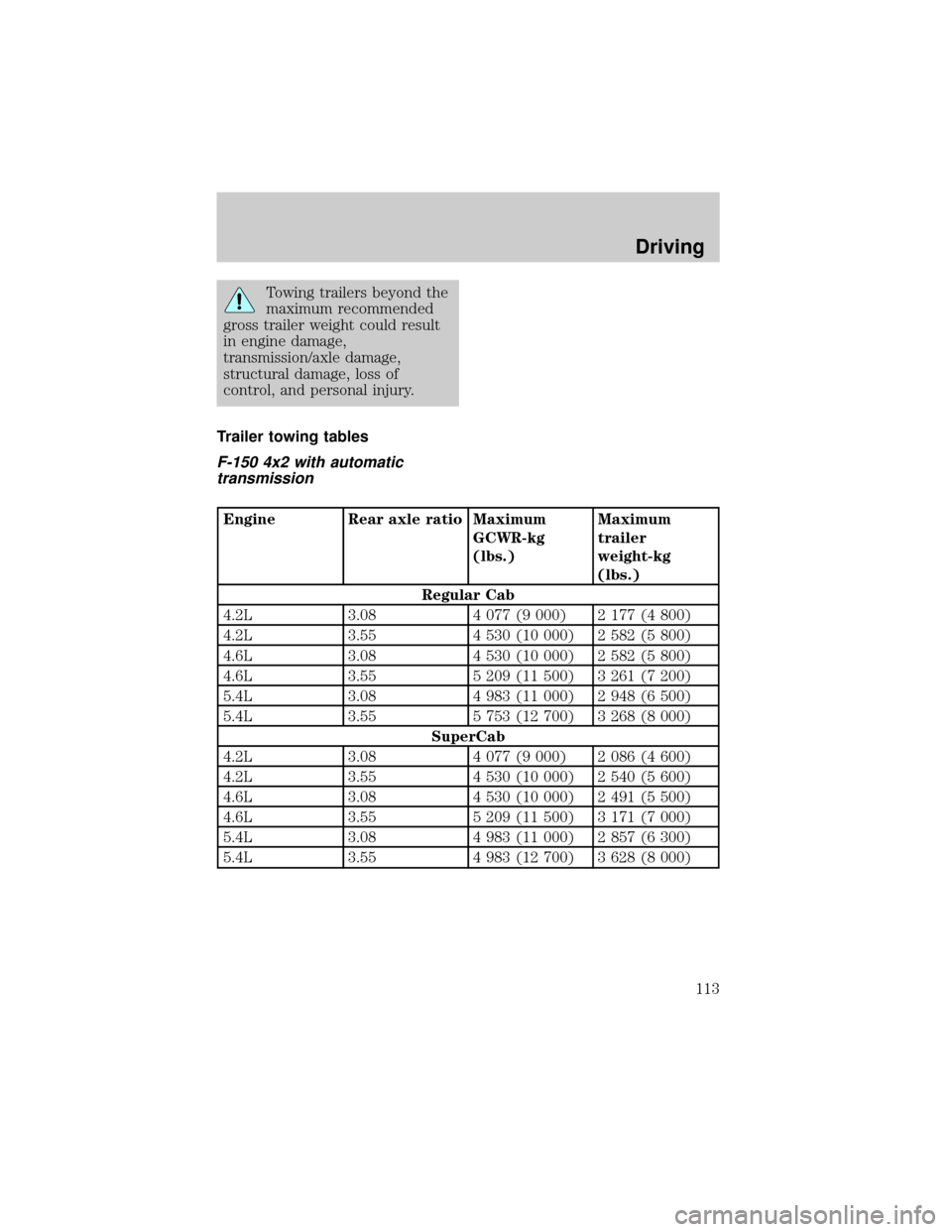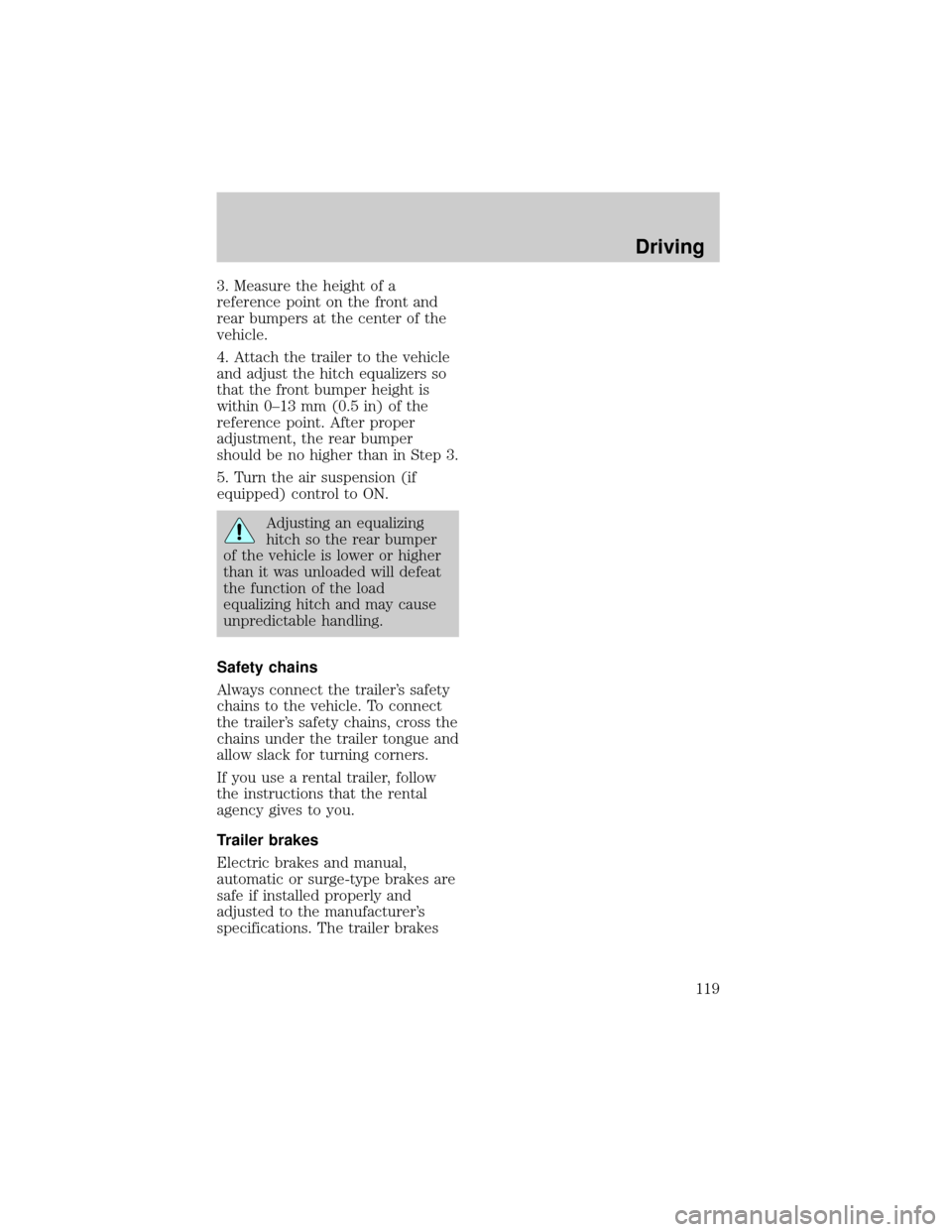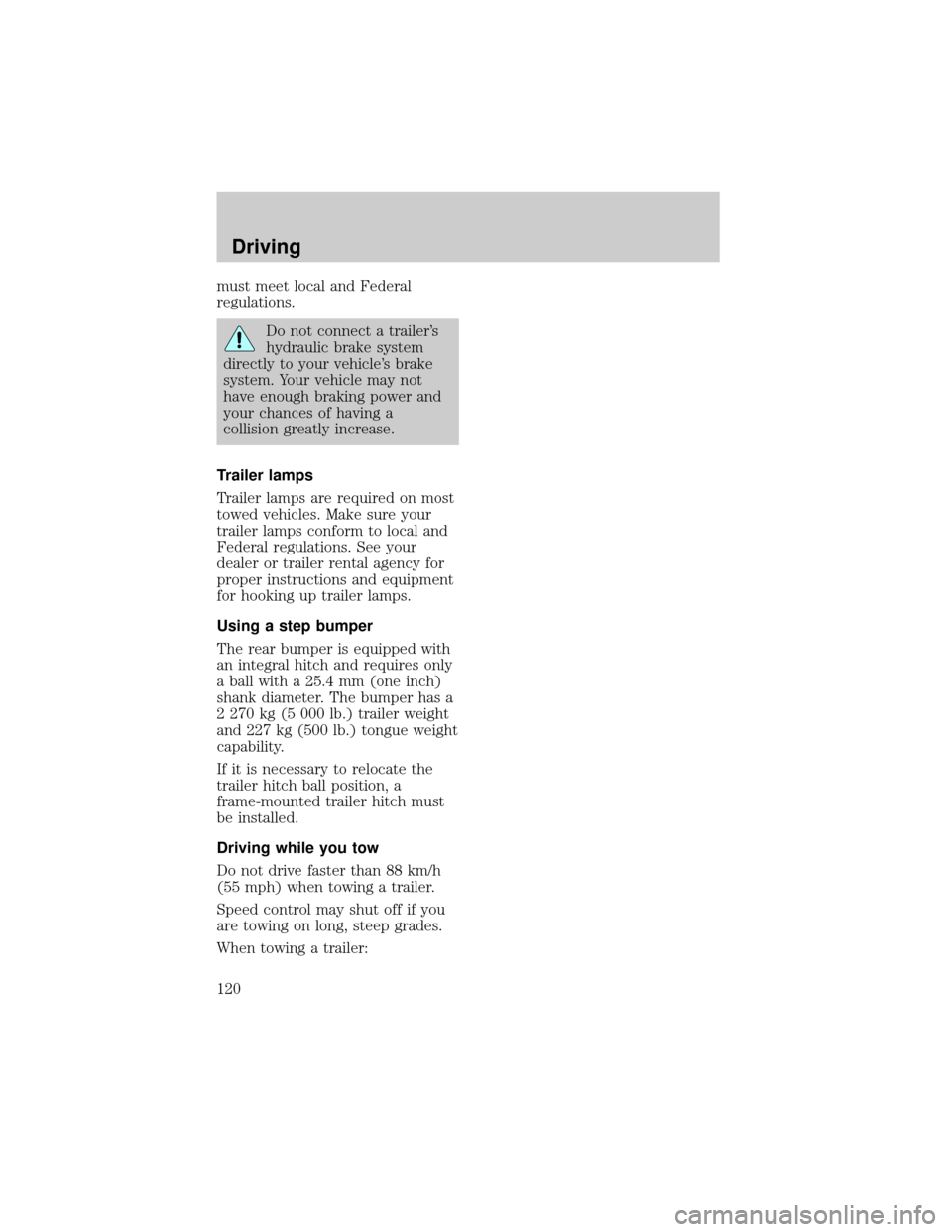FORD F150 1998 10.G Owners Manual
Manufacturer: FORD, Model Year: 1998, Model line: F150, Model: FORD F150 1998 10.GPages: 219, PDF Size: 1.49 MB
Page 111 of 219

on the following charts. This is the
maximum trailer weight your
vehicle can tow and must fall
below the maximum shown under
maximum trailer weight on the
chart.
DRIVING THROUGH WATER
Do not drive quickly through
standing water, especially if the
depth is unknown. Traction or
brake capability may be limited
and if the ignition system gets wet,
your engine may stall. Water may
also enter your engine's air intake
and severely damage your engine.
If driving through deep or standing
water is unavoidable, proceed very
slowly. Never drive through water
that is higher than the bottom of
the hubs (truck)/wheel rims (car).
Once through the water, always try
the brakes. Wet brakes do not stop
the vehicle as effectively as dry
brakes. Drying can be improved by
moving your vehicle slowly while
applying light pressure on the
brake pedal.
Driving
111
Page 112 of 219

TOWING A TRAILER
Your vehicle may tow a class I, II
or III trailer provided the
maximum trailer weight is less
than or equal to the maximum
trailer weight listed for your engine
and rear axle ratio on the following
charts.
Your vehicle's load capacity is
designated by weight, not by
volume, so you cannot necessarily
use all available space when
loading a vehicle.
Towing a trailer places an
additional load on your vehicle's
engine, transmission, axle, brakes,
tires and suspension. Inspect these
components carefully after any
towing operation.
Do not exceed the GVWR
or the GAWR specified on
the Safety Compliance
Certification Label.
Driving
112
Page 113 of 219

Towing trailers beyond the
maximum recommended
gross trailer weight could result
in engine damage,
transmission/axle damage,
structural damage, loss of
control, and personal injury.
Trailer towing tables
F-150 4x2 with automatic
transmission
Engine Rear axle ratio Maximum
GCWR-kg
(lbs.)Maximum
trailer
weight-kg
(lbs.)
Regular Cab
4.2L 3.08 4 077 (9 000) 2 177 (4 800)
4.2L 3.55 4 530 (10 000) 2 582 (5 800)
4.6L 3.08 4 530 (10 000) 2 582 (5 800)
4.6L 3.55 5 209 (11 500) 3 261 (7 200)
5.4L 3.08 4 983 (11 000) 2 948 (6 500)
5.4L 3.55 5 753 (12 700) 3 268 (8 000)
SuperCab
4.2L 3.08 4 077 (9 000) 2 086 (4 600)
4.2L 3.55 4 530 (10 000) 2 540 (5 600)
4.6L 3.08 4 530 (10 000) 2 491 (5 500)
4.6L 3.55 5 209 (11 500) 3 171 (7 000)
5.4L 3.08 4 983 (11 000) 2 857 (6 300)
5.4L 3.55 4 983 (12 700) 3 628 (8 000)
Driving
113
Page 114 of 219

F-150 4x2 manual transmission
Engine Rear axle
ratioMaximum
GCWR-kg
(lbs.)Maximum
trailer
weight-kg
(lbs.)Maximum
frontal area
of
trailer-m
(ft)
Regular Cab F-150
4.2L 3.08 2 944 (6 500) 1 041 (2 300) 5.52 (60)
4.2L 3.55 3 533 (7 800) 1 630 (3 600) 5.52 (60)
4.6L 3.08 2 944 (6 500) 997 (2 200) 5.52 (60)
4.6L 3.55 3 533 (7 800) 1 587 (3 500) 5.52 (60)
SuperCab F-150
4.2L 3.08 2 944 (6 500) 951 (2 100) 5.52 (60)
4.2L 3.55 3 533 (7 800) 1 540 (3 400) 5.52 (60)
4.6L 3.08 2 944 (6 500) 907 (2 000) 5.52 (60)
4.6L 3.55 3 533 (7 800) 1496 (3 300) 5.52 (60)
F-150 4x4 automatic
transmission
Engine Rear axle
ratioMaximum
GCWR-kg
(lbs.)Maximum
trailer
weight-kg
(lbs.)Maximum
frontal area
of
trailer-m
(ft)
Regular Cab F-150
4.2L 3.08 4 077 (9 000) 1 995 (4 400) 5.52 (60)
4.2L 3.55 4 530 (10 000) 2 449 (5 400) 5.52 (60)
4.6L 3.08 4 530 (10 000) 2 404 (5 300) 5.52 (60)
4.6L 3.55 5 209 (11 500) 3 084 (6 800) 5.52 (60)
5.4L 3.08 4 983 (11 000) 2 721 (6 000) 5.52 (60)
5.4L 3.55 5 753 (12 700) 3 492 (7 700) 5.52 (60)
SuperCab F-150
4.6L 3.08 4 530 (10 000) 2 313 (5 100) 5.52 (60)
Driving
114
Page 115 of 219

Engine Rear axle
ratioMaximum
GCWR-kg
(lbs.)Maximum
trailer
weight-kg
(lbs.)Maximum
frontal area
of
trailer-m
(ft)
4.6L 3.55 5 209 (11 500) 2 993 (6 600) 5.52 (60)
5.4L 3.08 4 983 (11 000) 2 721 (6 000) 5.52 (60)
5.4L 3.55 5 753 (12 700) 3 492 (7 700) 5.52 (60)
F-150 4x4 manual transmission
Trailer towing table (F-150 4x4 manual transmission)
Engine Rear axle
ratioMaximum
GCWR-kg
(lbs.)Maximum
trailer
weight-kg
(lbs.)Maximum
frontal area
of
trailer-m
(ft)
Regular Cab F-150
4.2L 3.08 2 944 (6 500) 861 (1 900) 5.52 (60)
4.2L 3.55 3 533 (7 800) 1 451 (3 200) 5.52 (60)
4.6L 3.08 2 944 (6 500) 816 (1 800) 5.52 (60)
4.6L 3.55 3 533 (7 800) 1 406 (3 100) 5.52 (60)
SuperCab F-150
4.6L 3.08 2 944 (6 500) 771 (1 700) 5.52 (60)
4.6L 3.55 3 533 (7 800) 1 360 (3 000) 5.52 (60)
F-250 4x2 automatic
transmission
Engine Rear axle
ratioMaximum
GCWR-kg
(lbs.)Maximum
trailer
weight-kg
(lbs.)Maximum
frontal area
of
trailer-m
(ft)
Regular Cab F-250
4.6L 3.31 4 756 (10 500) 2 630 (5 800) 5.52 (60)
Driving
115
Page 116 of 219

Engine Rear axle
ratioMaximum
GCWR-kg
(lbs.)Maximum
trailer
weight-kg
(lbs.)Maximum
frontal area
of
trailer-m
(ft)
4.6L 3.73 5 436 (12 000) 3 311 (7 300) 5.52 (60)
5.4L 3.31 5 436 (12 000) 3 265 (7 200) 5.52 (60)
5.4L 3.73 6 115 (13 500) 3 946 (8 600) 5.52 (60)
SuperCab F-250
4.6L 3.31 4 756 (10 500) 2 585 (5 700) 5.52 (60)
4.6L 3.73 5 436 (12 000) 3 265 (7 200) 5.52 (60)
5.4L 3.31 5 436 (12 000) 3 220 (7 100) 5.52 (60)
5.4L 3.73 6 115 (13 500) 3 900 (8 600) 5.52 (60)
F-250 4x2 manual transmission
Engine Rear axle
ratioMaximum
GCWR-kg
(lbs.)Maximum
trailer
weight-kg
(lbs.)Maximum
frontal area
of trailer-m
(ft)
Regular Cab F-250
4.6L 3.31 3 261 (7 200) 1 179 (2 600) 5.52 (60)
4.6L 3.73 3 533 (7 800) 1 451 (3 200) 5.52 (60)
SuperCab F-250
4.6L 3.31 3 261 (7 200) 1 133 (2 500) 5.52 (60)
4.6L 3.73 3 533 (7 800) 1 406 (3 100) 5.52 (60)
Driving
116
Page 117 of 219

F-250 4x4 automatic
transmission
Engine Rear axle
ratioMaximum
GCWR-kg
(lbs.)Maximum
trailer
weight-kg
(lbs.)Maximum
frontal area
of trailer-m
(ft)
Regular Cab F-250
4.6L 3.31 4 756
(10 500)2 449
(5 400)5.52 (60)
4.6L 3.73 5 436
(12 000)3 129
(6 900)5.52 (60)
5.4L 3.31 5 436
(12 000)3 084
(6 800)5.52 (60)
5.4L 3.73 6 115
(13 500)3 764
(8 300)5.52 (60)
SuperCab F-250
4.6L 3.31 4 756
(10 500)2 449
(5 400)5.52 (60)
4.6L 3.73 5 436
(12 000)3 129
(6 900)5.52 (60)
5.4L 3.31 5 436
(12 000)3 084
(6 800)5.52 (60)
5.4L 3.73 6 115
(13 500)3 764
(8 300)5.52 (60)
F-250 4x4 manual transmission
Engine Rear axle
ratioMaximum
GCWR-kg
(lbs.)Maximum
trailer
weight-kg
(lbs.)Maximum
frontal area
of trailer-m
(ft)
Regular Cab F-250
4.6L 3.31 3 261 (7 200) 952 (2 100) 5.52 (60)
4.6L 3.73 3 533 (7 800) 1 224 (2 700) 5.52 (60)
Driving
117
Page 118 of 219

Engine Rear axle
ratioMaximum
GCWR-kg
(lbs.)Maximum
trailer
weight-kg
(lbs.)Maximum
frontal area
of trailer-m
(ft)
SuperCab F-250
4.6L 3.31 3 261 (7 200) 952 (2 100) 5.52 (60)
4.6L 3.73 3 533 (7 800) 1 224 (2 700) 5.52 (60)
Preparing to tow
Use the proper equipment for
towing a trailer, and make sure it
is properly attached to your
vehicle. See your dealer or a
reliable trailer dealer if you require
assistance.
Hitches
Do not use hitches that clamp onto
the vehicle's bumper or attach to
the axle. You must distribute the
load in your trailer so that 10 to
15% of the total weight of the
trailer is on the tongue.
Load equalizing hitch
When hooking up a trailer using a
load equalizing hitch, always use
the following procedure:
1. Park the unloaded vehicle on a
level surface. With the ignition on
and all doors closed, allow the
vehicle to stand for several
minutes so that it can level.
2. Turn the air suspension (if
equipped) control to OFF.
Driving
118
Page 119 of 219

3. Measure the height of a
reference point on the front and
rear bumpers at the center of the
vehicle.
4. Attach the trailer to the vehicle
and adjust the hitch equalizers so
that the front bumper height is
within 0±13 mm (0.5 in) of the
reference point. After proper
adjustment, the rear bumper
should be no higher than in Step 3.
5. Turn the air suspension (if
equipped) control to ON.
Adjusting an equalizing
hitch so the rear bumper
of the vehicle is lower or higher
than it was unloaded will defeat
the function of the load
equalizing hitch and may cause
unpredictable handling.
Safety chains
Always connect the trailer's safety
chains to the vehicle. To connect
the trailer's safety chains, cross the
chains under the trailer tongue and
allow slack for turning corners.
If you use a rental trailer, follow
the instructions that the rental
agency gives to you.
Trailer brakes
Electric brakes and manual,
automatic or surge-type brakes are
safe if installed properly and
adjusted to the manufacturer's
specifications. The trailer brakes
Driving
119
Page 120 of 219

must meet local and Federal
regulations.
Do not connect a trailer's
hydraulic brake system
directly to your vehicle's brake
system. Your vehicle may not
have enough braking power and
your chances of having a
collision greatly increase.
Trailer lamps
Trailer lamps are required on most
towed vehicles. Make sure your
trailer lamps conform to local and
Federal regulations. See your
dealer or trailer rental agency for
proper instructions and equipment
for hooking up trailer lamps.
Using a step bumper
The rear bumper is equipped with
an integral hitch and requires only
a ball with a 25.4 mm (one inch)
shank diameter. The bumper has a
2 270 kg (5 000 lb.) trailer weight
and 227 kg (500 lb.) tongue weight
capability.
If it is necessary to relocate the
trailer hitch ball position, a
frame-mounted trailer hitch must
be installed.
Driving while you tow
Do not drive faster than 88 km/h
(55 mph) when towing a trailer.
Speed control may shut off if you
are towing on long, steep grades.
When towing a trailer:
Driving
120